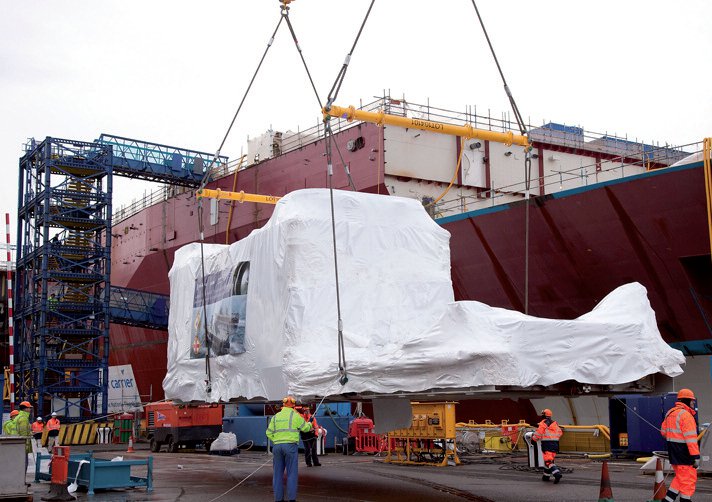In January, global spreader beam manufacturer, Modulift, designed and built spreaders to lift the world’s most powerful gas turbine. Rolls-Royce, the global power systems company, installed the gas turbine onto the Royal Navy’s new aircraft carrier, HMS Queen Elizabeth, at Babcocks Rosyyth Shipyard in Scotland.
Having previously worked together on a number of successful heavy lift projects in the past, Rolls-Royce approached lifting experts Modulift in 2010 with the task, knowing that they were in safe hands. The project involved lifting and installing the turbines, which were housed in a steel protective package onto the ships structure. In order to install the 120t MT30 turbines, Modulift carried out various skid weighing tests and a mammoth amount of compliant documentation, to ensure that the project went to plan.
Over time, the MT30 gas turbines will be installed on a number of naval ships, which will provide two thirds of the 109MW needed to power the 65,000t ships – enough to power a small town.
To meet Rolls-Royce high specification requirements, Modulift provided three spreader beams to lift the turbine in a ‘one over two’ formation. Instead of using off the- shelf products, the beams were specially fabricated in order to meet the custom strut length requirements, as specified by Rolls-Royce.
When it came to Modulift designing the rig plan, the level of quality and accuracy was extremely controlled. Any technical or miscalculation errors could have resulted in the gas turbine capsizing when lifted into place by the Goliath crane. Due to the quality of Modulift’s rig design, the turbine was accurately lifted level at 0.2 degrees.
Sue Caples, operations manager and head engineer at Modulift said, “The Gas Turbine had a 75/25 offset centre of gravity, which meant that we had to design a lifting rig that would enable the turbine to be lifted level despite the extreme offset CG. We achieved this by designing a ‘1 over 2’ Lifting Rig that had different length top slings so that the crane hook would be directly over the centre of gravity during the lift. It is important for loads to be lifted level particularly for installations such as this one, and it was a great success because the load was level within 0.2 degrees from horizontal. We are very pleased to have provided the lifting equipment for such a prestigious project.”
The spreader beams needed to be proof load tested for this project, and this was conducted using Modulift’s own compression test rig. Once all of the spreader beams were assembled they were individually loaded into the compression test rig and the designated proof load was applied, (for this project the proof load factor was SWL + 25 per cent). Testing of all of the spreader beams was successfully completed without any issues and a final post-test MPI examination verified that there were no weld defects after testing. The drop links for the spreader beams were then proof load tested in Modulift’s own tensile test rig using the same proof load factor as the spreader beams.
Author; Unknown
Source:
http://www.hoistmagazine.com/features/lifting-the-worlds-most-powerful-gas-turbine/


